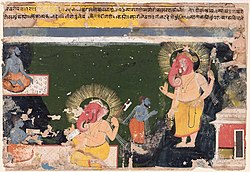![]()
Lord Ganesha, the beloved elephant-headed deity of Hinduism, is one of the most recognizable and revered gods in India and beyond. His iconic image, with a plump body, elephant head, and a jovial demeanor, symbolizes wisdom, intellect, and the removal of obstacles. However, the history of Lord Ganesha’s evolution and emergence as a prominent deity is a complex and fascinating journey that spans thousands of years and transcends geographical boundaries.
The Early Traces
The earliest traces of Ganesha’s existence can be found in ancient artifacts and archaeological discoveries. One notable discovery is the Gardez Ganesha, a 7th-century marble sculpture found in Gardez, Afghanistan. This artifact, once displayed at Dargah Pir Rattan Nath in Kabul, serves as evidence of Ganesha’s early presence beyond the Indian subcontinent.
![]() 7th-century marble Ganesha found in Gardez, Afghanistan, and once displayed at Dargah Pir Rattan Nath, Kabul.
7th-century marble Ganesha found in Gardez, Afghanistan, and once displayed at Dargah Pir Rattan Nath, Kabul.
The Debate on Ganesha’s Origins
Scholars have long debated the origins of Ganesha. Some have suggested that Ganesha may have been an emerging deity in India and Southeast Asia around the 2nd century CE based on archaeological excavations in places like Mathura. However, the lack of concrete evidence in ancient Brahmanic literature before the 5th century CE leaves room for speculation about his early history. The evidence for Ganesha’s more ancient existence may reside outside Brahmanic traditions and geocultural boundaries of India.
Possible Influences
The historical influences and origins of Ganesha are subjects of much speculation. Some theories suggest connections to tribal traditions and animal cults, but these remain largely speculative. One theory links Ganesha to the four Vinayakas, evil spirits who created obstacles but could be easily propitiated. These Vinayakas are mentioned in Hindu mythology and the Buddhist Tantras. Depictions of elephant-headed figures, possibly representing Ganesha, appear in Indian art and coinage as early as the 2nd century CE.
Ganesha in Vedic and Epic Literature

Ganesha does not prominently appear in Vedic literature, although there are references to “Leader of the group” (gaṇapati) in the Rig Veda. These references are not directly related to the modern Ganesha but were later adopted for the worship of Ganesha.
In the Mahabharata, a late interpolation tells the story of how the sage Vyasa asked Ganesha to serve as his scribe to transcribe the epic. This story is not considered part of the original text, but it highlights Ganesha’s association with mental agility and learning.
The Puranic Period
![]()
The Puranic corpus, which includes texts composed from around the 5th century CE onwards, contains many stories about Ganesha’s life and attributes. These texts reveal how Ganesha acquired an elephant’s head and his role as a remover of obstacles. However, scholars have noted that Ganesha-centric narratives concentrate on a limited number of incidents, primarily his birth, elephant head, and single tusk.
Formal Acceptance and Spread
Ganesha’s rise to prominence was codified in the 9th century when he was formally included as one of the five principal deities of Smartism, a Hindu tradition. Adi Shankara, a philosopher of that time, popularized the worship of the five forms (Panchayatana puja) system, which included Ganesha as a complementary deity.
Scriptures such as the Ganesha Purana and Mudgala Purana were developed between the 12th and 13th centuries, further establishing Ganesha’s significance. The Ganesha Sahasranama, a litany of a thousand names and attributes of Ganesha, also emerged as part of the Puranic literature.
Beyond India and Hinduism
Ganesha’s worship extended beyond India through cultural and commercial contacts. Traders and merchants, in particular, worshipped Ganesha for success and as a protector during their ventures. Ganesha’s influence reached Southeast Asia, where his image can be found in various forms, often alongside Shiva sanctuaries.
In Buddhism, Ganesha appears both as Vināyaka and a Hindu demon form. Tibetan and East Asian Buddhism also feature Ganesha in various roles, reflecting regional influences.
In Indonesia, despite being a predominantly Muslim country, Ganesha is regarded as a symbol of knowledge and wisdom. He is featured in universities’ logos and even appeared on currency.
The history of Lord Ganesha is a testament to the complex interplay of cultures, beliefs, and historical developments. From his early traces in archaeological finds to his prominence in Hinduism and beyond, Ganesha’s journey is a fascinating exploration of the evolution of religious traditions and cultural exchanges.
Today, Lord Ganesha remains a beloved and iconic deity, symbolizing intellect, wisdom, and the ability to overcome life’s obstacles.







